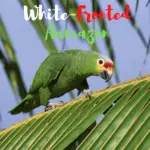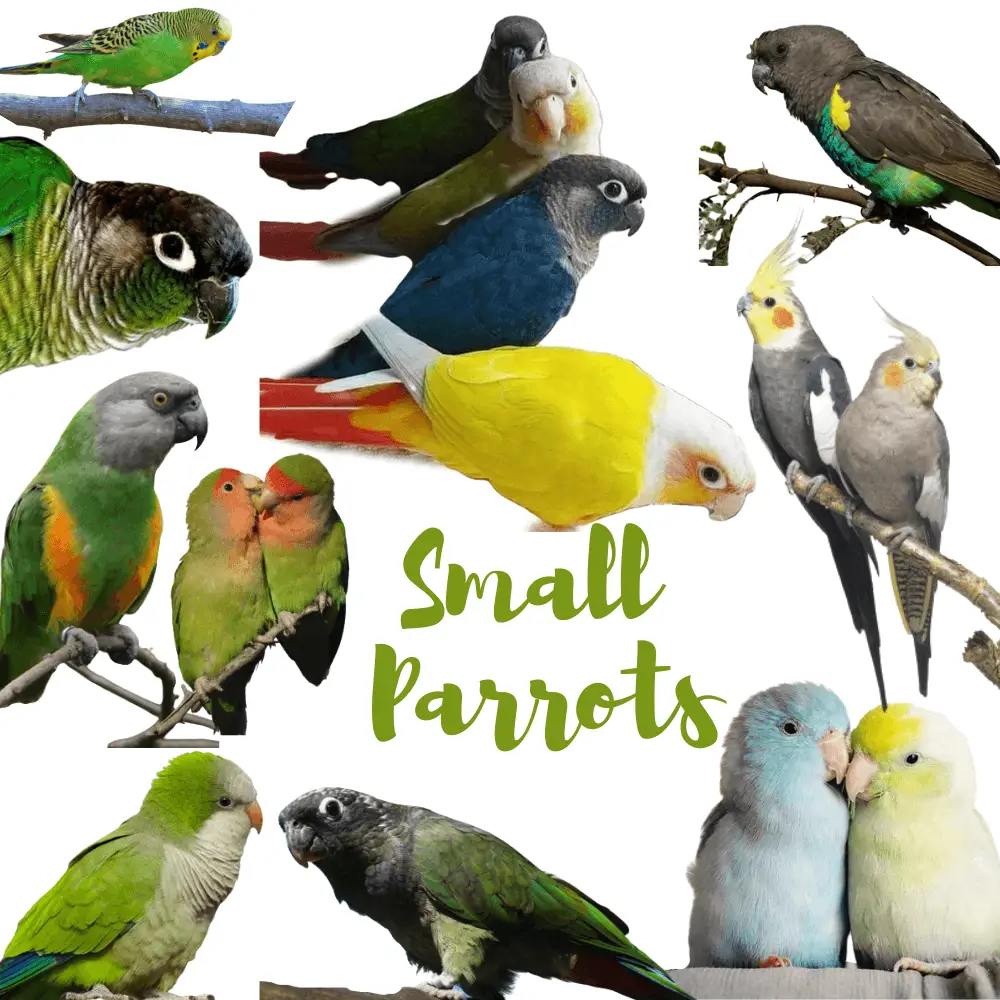
The little parrots or Small parrots list: Among the different breeds of parrots that exist, some may be more suitable for you than others. This is for example the case of small parrots. If you want to adopt one or more parrots, but you have never had one before, small jigs can be a good choice to start with. Learn about some of the many species of small parrots.
Different Types of Small Parrots
Parrots have captivated many people for hundreds of years, offering beauty, affection, and intelligent companionship to people around the world. Even those who do not call themselves bird lovers can rarely resist the charms of a well-behaved parrot.
Too often, however, those who would like to invite a parrot into their lives refrain from adopting one because they are not familiar with the many varieties available. Not all parrots are extremely large. Read on to discover some smaller, more manageable species that can make great pets for the right people.
Read on to discover some smaller, more manageable species that can make great pets for the right people.
Poicephalus
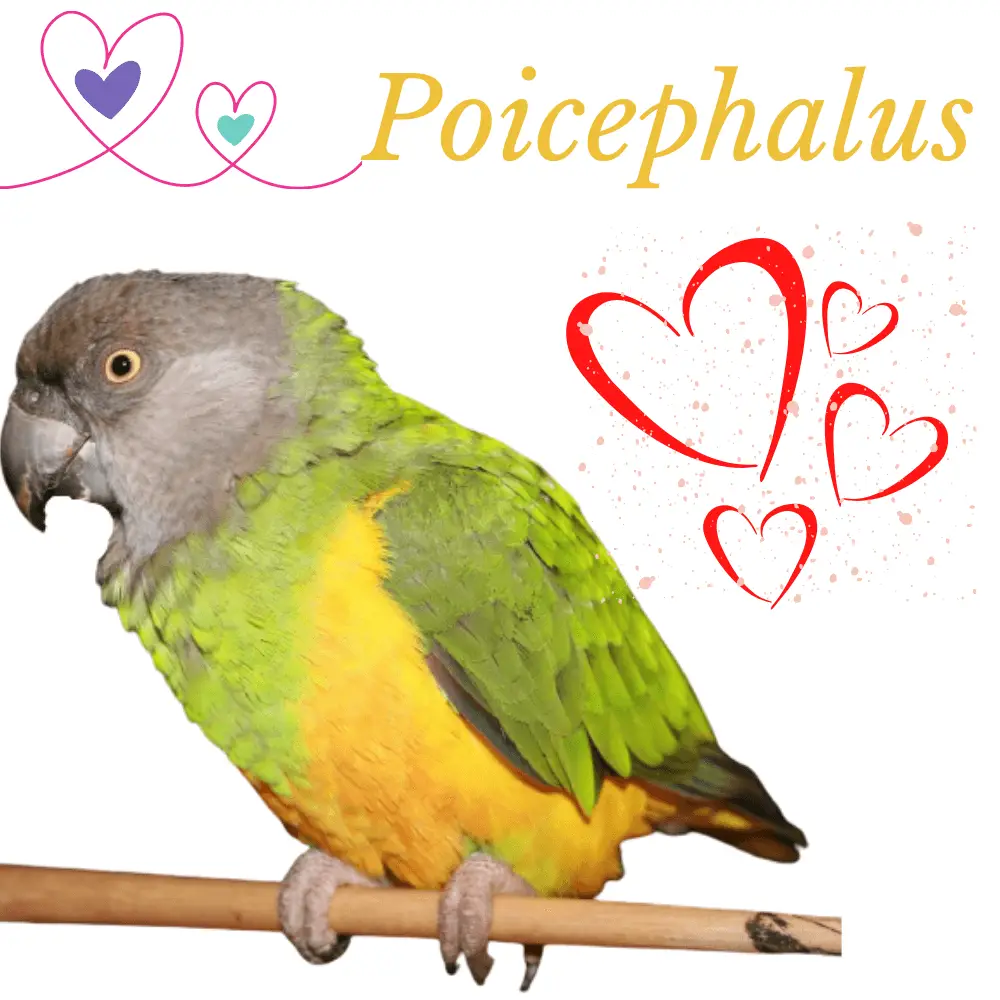
The Poicephalus is not the best known of parrots, wrongly! This small parrot is native to the African continent and is successful as a pet bird. He has a side that is both tender and fun and always seems to be in a good mood. In addition, he has a certain gift for imitation… So you can try to teach him to repeat some sounds or words. Be aware, however, that he is not one of the most able-bodied parrots to speak.
Compact and not very noisy, it is ideal if you live in an apartment! He is easily tamed and loves to play. He will appreciate having several toys available to him in his cage. You will find in our store many models of games and toys for your little parrots. You will be able to observe them for long moments having fun.
Also, provide them with a suitable cage containing all the accessories necessary for their daily life.
Jardiland advice: games are very useful for the well-being of small parrots, which need to be kept busy and stimulated.
There are about ten species of Poicephalus, but some are only found in the wild. Among the most widespread species as pet birds, we find the Youyou parrot, Meyer’s parrot, and more rarely the red-capped parrot and the brown-headed parrot.
Poicephalus species
The best known is undoubtedly the Senegal parrot, also called the Parrot of Senegal. It measures between 20 and 26 centimeters. Its plumage is composed of several colors: green on the majority of the body, gray on the head with silvery cheeks, and yellow or orange on the belly. The most common is the one with a yellow belly. His eyes are also yellow-orange.
The Youyou has an affectionate and playful character, he is funny and you will get attached to him very easily! He too will quickly become attached to you… if you take a young enough bird and if he has been raised by hand, he will be able to be sociable with all the members of the family. You should know that the Youyou tends to be exclusive with its master and sometimes jealous… The first written description that we have of this little parrot dates from 1766!
Meyer’s parrot
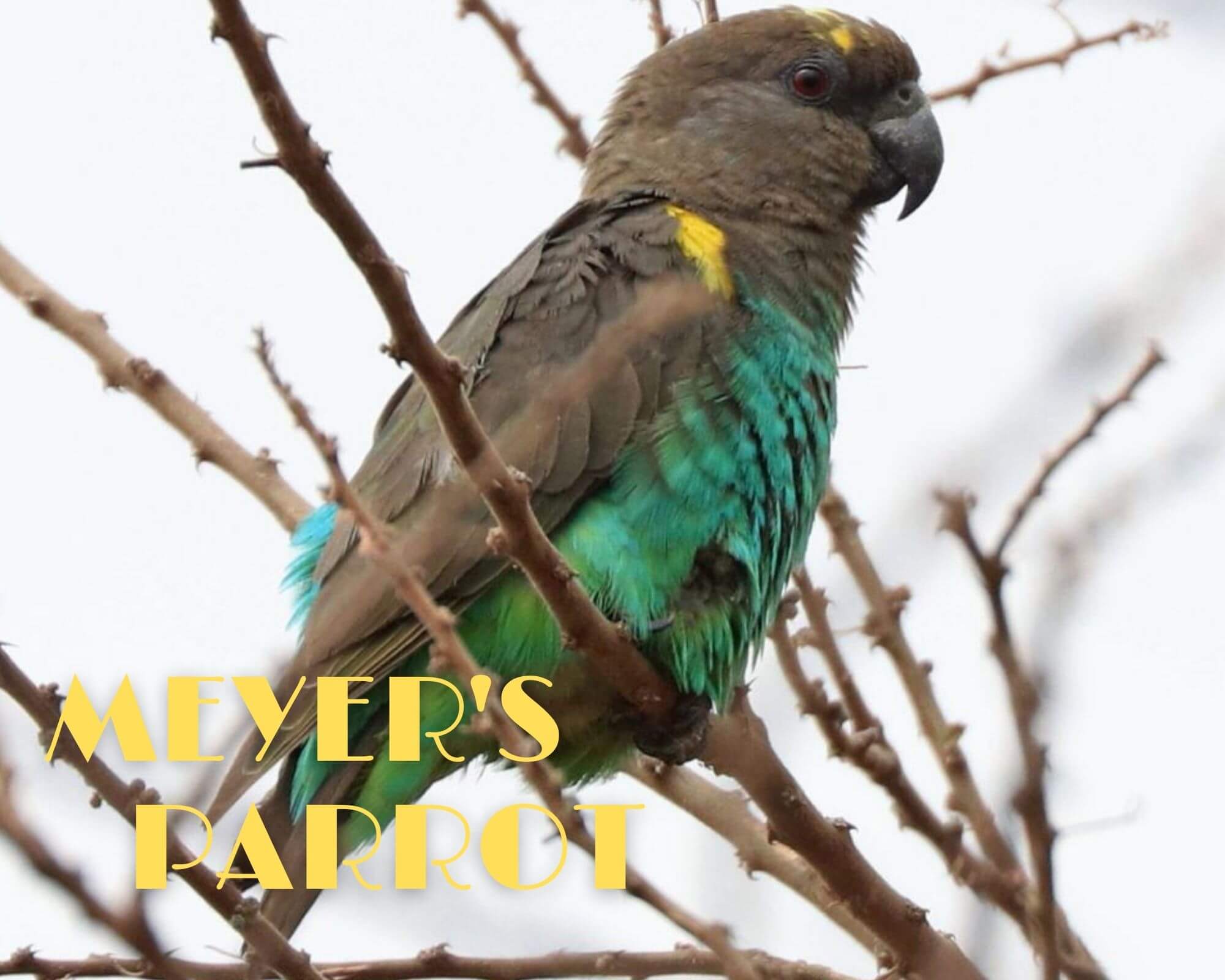
The colors of Meyer’s parrot range from brown-gray on the head, nape, and upper breast, to gray-black on the back and wings, with a green border on the feathers. On the rest of the breast and the top of the tail, we notice various shades of blue. In addition, yellow is found on the top of the wings as well as on the forehead. Its height varies from 21 to 25 centimeters, its weight is about 110 grams.
In the wild, Meyer’s parrot lives in many African countries: Cameroon, Mozambique, Angola, Tanzania, Sudan, Kenya…
Red-capped parrot
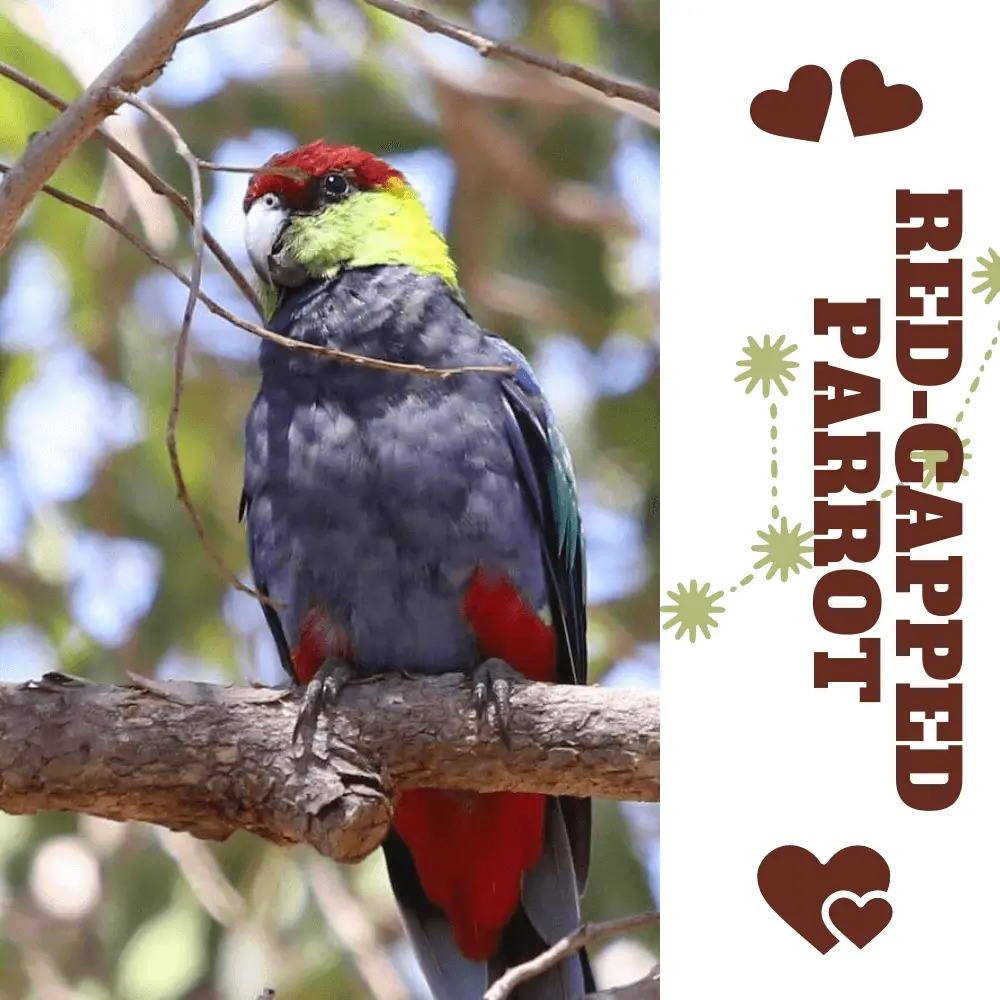
The red-capped parrot is also called the Jardine parrot. A little larger than the two previous species, it measures up to 28 centimeters. It is distinguished by the red color located on the forehead, shoulders, and thighs. The rest of the plumage is green.
The brown-headed parrot is less colorful. If it still has a majority of green, its head and neck are brown or brown-gray. Its beak has the particularity of having two colors, gray for the upper part and grey-white for the lower part.
Green Cheek Conure
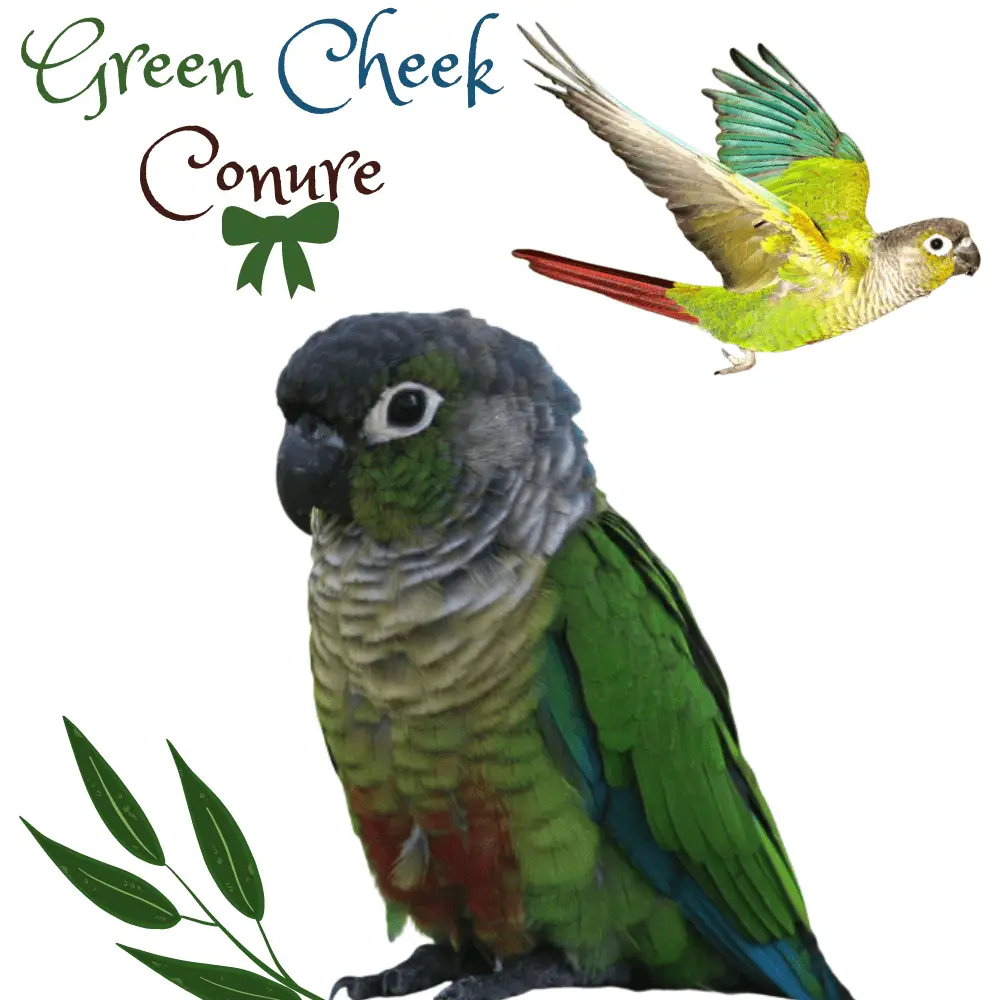
The green-cheeked conure, or Molina’s conure, is an easy-going little parrot! It has many qualities that make it a pleasant companion bird. Because she is both cuddly and affectionate, but also curious and playful. Its life expectancy can be up to 30 years. In the wild, this small parrot is present in almost all of South America.
It is a small size since its size is around 26 centimeters and its weight of 80 grams. Its plumage is mostly green, a color that stands out even more on the cheeks (hence its name!). His chest is more of a bronze color (between brown and gold). The forehead, the top of the head, and the nape are black.
We notice a nice turquoise blue on the outside of the wings and red on the tail feathers. She also has white eye-rings.
This little parrot will bring you a lot of affection: he can snuggle up in your hand or around your neck. But he is also lively and cheerful, showing curiosity and intelligence. He needs to be kept busy and stimulated. To do this, get him games and train him to talk by having him repeat words or sounds.
Want to know more? Check out our article on parrot breeds.
Jardiland advice: the conure can be greedy… make it happy by giving it foods it likes but respecting its diet. This one is above all composed of a mixture of seeds. You will supplement with fresh fruits and vegetables and be careful not to give him prohibited foods!
Want to know more? Discover our article on prohibited food for the parrot.
The colors of the Pyrrhura molinae Parakeet
You can find Molina conures in different colors. First of all, there is the wild type, which uses the colors mentioned above. They consist of mainly green plumage, also green cheeks, a bronze-colored chest, and black on the top of the head and the nape of the neck. By the way, the end of the wings is turquoise blue and the tail is red. The beak and legs are dark in color.
Furthermore, color mutations exist in addition to this “wild” standard. The opaline mutation causes yellow to appear on the inside of the wings as well as on the thighs and a little on the abdomen. The latter is no longer “bronze” but red, in varying quantities depending on the individual. The beak of the opaline conure is black but its legs are light.
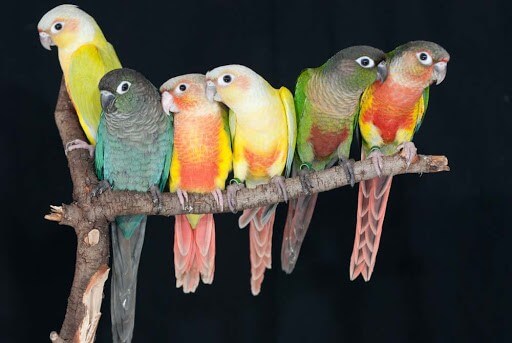
Another mutation exists, it is the cinnamon conure.
In this case, it keeps almost the same colors as the wild conure, but they are toned down!
For example, the somewhat intense green of the wild color becomes light green. In addition, the head becomes cinnamon-gray, while retaining its green cheeks. The beak also clears up as well as the claws.
Did you know that there are conures that marry the 2 mutations, opaline, and cinnamon? This mutation is called “ pineapple ”. The bird then has a majority of yellow, a clear head, and green wings.
As for the turquoise mutation, it shows a magnificent blue-green color and grays on the rest of the body. There may be turquoise opaline conures, in which we find the yellow color under the wings.
Our Jardiland stores exclusively offer farmed birds.
In order to preserve wildlife, the animal you have just acquired must not be released into the natural environment.
List of Conure species
- Ochre-marked parakeet, Pyrrhura cruentata.
- Maroon-bellied parakeet, Pyrrhura frontalis.
- Blaze-winged parakeet, Pyrrhura devillei – traditionally a subspecies of P. frontalis.
- Crimson-bellied parakeet, Pyrrhura perlata – formerly P. rhodogaster.
- Pearly parakeet, Pyrrhura lepida – formerly P. perlata.
- Green-cheeked parakeet, Pyrrhura molinae.
- Painted parakeet, Pyrrhura picta.
- Sinú parakeet, Pyrrhura (picta) subandina – possibly extinct.
- Todd’s (Perijá) parakeet, Pyrrhura (picta) caeruleiceps.
- Azuero parakeet, Pyrrhura (picta) eisenmanni.
- Venezuelan parakeet, Pyrrhura emma – Formally considered a subspecies of P. leucotis.
- Santarém (Hellmayr’s) parakeet, Pyrrhura amazonum – traditionally a subspecies of P. picta.
- Madeira parakeet, Pyrrhura snethlageae
- Bonaparte’s (Deville’s) parakeet, Pyrrhura lucianii – traditionally a subspecies of P. picta.
- Rose-fronted parakeet, Pyrrhura roseifrons – traditionally a subspecies of P. picta.
- Wavy-breasted parakeet, Pyrrhura (roseifrons) peruviana.
- White-eared (maroon-faced) parakeet, Pyrrhura leucotis.
- Grey-breasted parakeet, Pyrrhura griseipectus.
- Pfrimer’s parakeet, Pyrrhura pfrimeri – traditionally a subspecies of P. leucotis.
- Fiery-shouldered parakeet, Pyrrhura egregia.
- Santa Marta parakeet, Pyrrhura viridicata.
- Maroon-tailed parakeet, Pyrrhura melanura.
- El Oro parakeet, Pyrrhura orcesi.
- Black-capped (rock) parakeet, Pyrrhura rupicola.
- White-necked parakeet, Pyrrhura albipectus.
- Flame-winged (brown-breasted) parakeet, Pyrrhura calliptera.
- Red-eared parakeet, Pyrrhura hoematotis.
- Rose-headed (rose-crowned) parakeet, Pyrrhura rhodocephala.
- Sulphur-winged parakeet, Pyrrhura hoffmanni.
Budgerigar
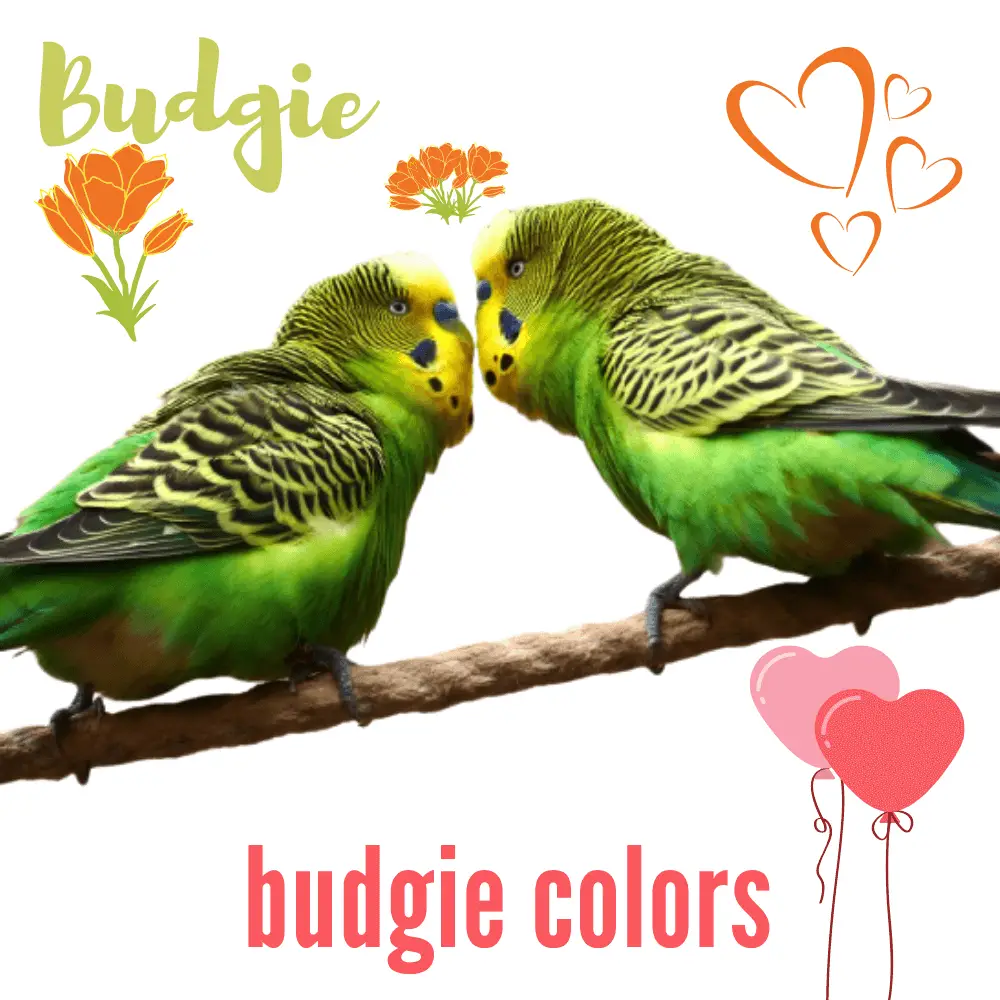
In adults, the blue cere contrasts with the forehead, front of the face, and throat which are pale yellow. The latter is covered with a line of small black dots. The area that is located under the malar region is purple. The middle part of the hood, which continues behind the eye to the nape, is covered with alternating thin black and pale yellow bars. These bars widen on the mantle and on the wing – coverts, forming a kind of scales.
The underparts and underside of the wings, lower back, and rump create a nice light green ensemble. The tail is dull bluish, with a central yellow stripe on the lateral rectrices.
The female has a brownish cere, the immatures are duller with bars on the forehead. The black throat speckles are absent.
Budgies frequent a wide variety of open habitats, including sparse forests, savannahs, and lightly wooded grasslands.
They also like stretches of mallee, cultivated land, plant formations that grow along rivers, dry scrub, and open plains. They penetrate into desert areas with mulga (Acacias). Although they are able to survive many days without water, these birds are never very far from a source or a water point.
In regions where fruit production is regular, in others where it is stable for very long periods, movements are quite easily predictable. In the far south, vagrants only exist in the event of prolonged drought and wanderers return to their territory with the first rains and recolonize them as soon as the hydrographic level has returned to normal.
Cockatiel

Along with the Budgerigar, it is arguably one of the most common parrots and cage birds in the world.
In adults, the head and base of the crest are yellow. The ear coverts, the posterior part of which is generally paler, are orange. Nape and long crest feathers are grey.
The upper parts show a dark dove-grey wash. The wings are gray but display a large white patch on the coverts and secondaries. The underparts are paler grey. The tail varies from medium gray to dark gray but the base of the upper tail coverts is paler. The beak is grey, the irises dark brown. The legs are grey-brown.
The female and immature males have a less contrasting orange patch on their faces. The rump, tail, and flanks have thin bars which are quite conspicuous. The yellowish outer rectrices are barred grey. The underside of the rectrices is slightly barred.
Cockatiels are gregarious and extremely social birds, they need a wide repertoire of calls to communicate or express their feelings. In-flight, they utter “queel, queel-queel” which has a plaintive sound. You can also hear “weero”, which gives them their vernacular name in Australia. Cockatiels possess great power to imitate other birds.
In the aridest areas, cockatiels are observed in pairs or in groups that can gather up to a hundred individuals. When feeding, groups contain an average of 27 members. However, gatherings of up to 1,000 birds have already been seen near landfills containing plant husks from rice hulls. Near water points, cockatiels are often associated with budgies (Melopsittacus undulatus). When they land, they perch on large tree branches.
Cockatiels feed twice a day: in the morning, shortly after sunrise, they consume about 2.72 grams of plant matter. In the evening, about an hour and a half before nightfall, they swallow a mass of about 4.25 grams, which makes almost 7 grams for the whole day.
Small parrots types
List of cockatiel species Read more about cockatiel:
Lovebird
Lovebirds ( Agapornis sp. ) are small Psittacidae living in southern Africa, including Madagascar
Distribution
Lovebirds are small parrots living primarily in southern and southeastern Africa.
Lifespan: 12 to 15 years
List of Lovebird species
According to the reference classification (version 2.2, 2009) of the International Ornithological Congress ( phylogenetic order ):
- Agapornis canus – Grey-headed Lovebird
- Agapornis pullarius – Red-headed Lovebird
- Agapornis taranta – Abyssinian Lovebird
- Agapornis swindernianus – Black-collared Lovebird
- Agapornis roseicollis – Peach-faced Lovebird
- Agapornis fischeri – Fischer’s Lovebird
- Agapornis personatus – Masked Lovebird
- Agapornis lilianae – Lilian’s Lovebird
- Agapornis nigrigenis – Black-cheeked Lovebird
- Gray headed lovebird
- Red-headed lovebird
- Yellow collared lovebird
- Rosy faced lovebird
The Smallest Parrot you have ever seen – Tiny egg rescue
SOURCE:A Chick Called Albert

